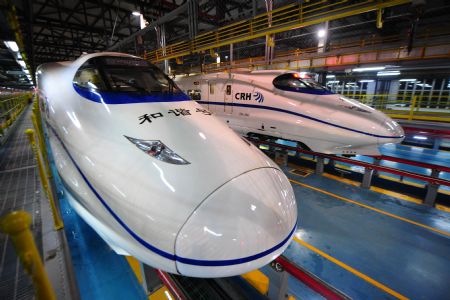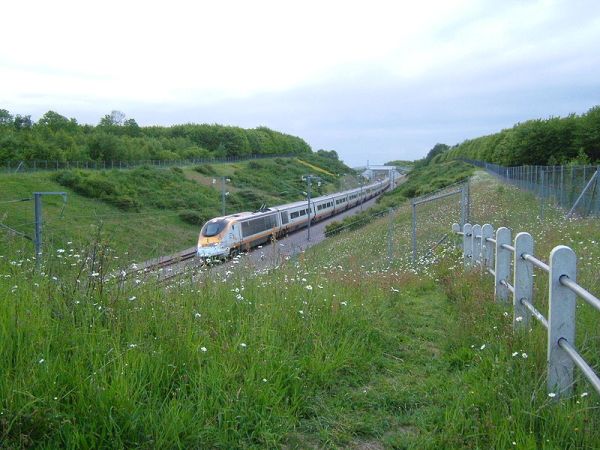
In political terms, Senator Bob Brown’s call for a new study on a VFT or very fast train between Melbourne-Canberra-Sydney risks provoking some fierce green negativity.
However it probably says something about the chances for that issue getting an airing that since Friday when he launched the proposal it has vanished into media invisibility, thanks no doubt to inspired or unlucky timing as the case may be. The Melbourne Storm fraud, the ANZAC holiday weekend, and the continued leaking of the Henry Taxation Review all killed the VFT story in its tracks, so to speak.

But what will the rank-and-file Greens do to the notion? If windmills can cause so much opposition among greens to what in some circumstances can be a useful boost to renewable energy because of the apparently real threats they pose to bird life…and the tranquil views sought by so many tree changers…what exactly are they going to say about 320 kmh trains rocketing through the parrot rich woods and fields of the southern highlands?
Or being powered by electricity generated by fossil carbon releasing coal fired power stations? Railway permanent ways do not just scar the countryside, and areas of natural beauty, but make cuttings that involve the collapsing of hillsides that are of significant durability on a geological time scale, and every bit as invasive as major highway construction. And they create a noise problem as long as the route.

In Europe the environmental impact of high speed railways is diluted by the extensive changes historically made to the landscape by higher population densities, and by layers of development and industrialisation. This is not the case in Australia, even in the south-eastern corner. We live in a place that is emptier and quieter than any other economically developed nation. We generate the vastly greater proportion of our electricity by burning coal and liberating fossil carbon. In France however the trains run on electricity which comes from turbines turned by steam superheated by nuclear fission, which is achieved by ‘managing’ the relative proximity of rods of enriched uranium, or in some cases plutonium. It’s clean, but scary power.
Thus understanding the nevertheless impressive case for railway expansion, whether it is to be very fast, or for rather less money, faster than before, becomes a process of understanding the desperately pressing matter of reducing the release of fossil sourced carbon. We can’t resolve the issues of radically improving rail infrastructure without dealing with the sources of the power it requires.
Rail transport is like fossil carbon reduction, an issue a coal dependant society continues to find all too hard to do anything about. This is different to the situation in air transport, where the pursuit of non fossil carbon releasing fuel substitutes is driven by sensitivity to rising oil prices rather than any other factor, contrary to what the airlines would have us believe.
(The ultimate goal of the airline industry, which is algal grown octanes with zero impact on food crop production, is perhaps two to three decades away from realisation, but it would have obvious benefits in terms of replacing fossil carbon releasing fuels in shipping and surface transport and perhaps even power generation.)
Brown referred to a Melbourne-Canberra-Sydney route. Canberra is a big complication to a VFT in that it involves engaging on a large scale one of the natural enemies of fast rail in general, which is complex hilly terrain.
The fastest passenger railway route on earth, the Wuhan-Guangzhou line, which began services in December 2009, is 922 kilometres long between the major two stations, or coincidentally, very similar to the likely length of an all new high speed line between Sydney and Melbourne that avoids the worst of the natural obstacles caused by high country around and to the south of Canberra.
The Wuhan-Guangzhou link took 4.5 years years to build, including 177 kilometres of twin track tunnelling. The non-stop service between the two large cities is currently scheduled at 2 hours 57 minutes at an average speed of 313 kmh in trains that reach a top speed of 350 kmh, and have in a trial run exceeded 390 kmh.
However most of the scheduling involves services stopping at some or all of the 12 major centres between Wuhan and Guangzhou as those intermediate express markets are considered essential to the overall viability of the state owned line.
The metal wheel on metal rail technology China is using is now going into a speed range which had previously been seen as belonging exclusively to magnetic levitation or maglev systems, but they are currently in eclipse as that contact free technology has failed to scale up into a workable proposition, in China where a short haul maglev link exists between Pudong Airport and Shanghai, or anywhere else.
[youtube]https://www.youtube.com/watch?v=1xwTHZ80B14[/youtube]
A photo gallery of what is now the fastest passenger train route on earth is contained in the YouTube above. The one below is a video which mostly illustrates the rail experience.
Both deserve a close study for what they have to say about fast rail, and China.
[youtube]https://www.youtube.com/watch?v=_LnmxJVPmZc&feature=related[/youtube]








Crikey is committed to hosting lively discussions. Help us keep the conversation useful, interesting and welcoming. We aim to publish comments quickly in the interest of promoting robust conversation, but we’re a small team and we deploy filters to protect against legal risk. Occasionally your comment may be held up while we review, but we’re working as fast as we can to keep the conversation rolling.
The Crikey comment section is members-only content. Please subscribe to leave a comment.
The Crikey comment section is members-only content. Please login to leave a comment.